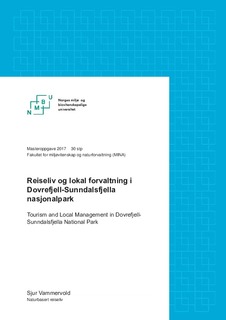| dc.contributor.advisor | Aas, Øystein | |
| dc.contributor.author | Vammervold, Sjur | |
| dc.coverage.spatial | Norway, Dovrefjell-Sunndalsfjella | nb_NO |
| dc.date.accessioned | 2018-09-27T11:46:22Z | |
| dc.date.available | 2018-09-27T11:46:22Z | |
| dc.date.issued | 2017 | |
| dc.identifier.uri | http://hdl.handle.net/11250/2564991 | |
| dc.description.abstract | Siden starten på 2000-tallet har det skjedd en rekke endringer i forvaltningen av norske nasjonalparker. Forbudet mot kommersiell aktivitet i nasjonalparkene er blitt opphevet og nasjonalparkene forvaltes nå av lokale nasjonalparkstyrer. En del av årsaken til disse endringene var stridene som oppsto mellom lokale aktører og statlig verneforvaltning under en rekke konfliktfylte verneprosesser. Reiselivet ser muligheter tilknyttet verdiskapning i nasjonalparkene og er i stor grad avhengig av nasjonalparkstyret gjennom samarbeid og dispensasjoner. Denne oppgaven undersøker hvordan lokal forvaltning påvirker reiselivet i Dovrefjell-Sunndalsfjella nasjonalpark og forholdet dem imellom. Oppgaven er avgrenset til å fokusere på medvirkning, næringsutvikling, nasjonale og lokale interesser og nasjonalparkstyrets handlingsrom.
For å besvare dette, er det gjennomført intervjuer med representanter fra Dovrefjell nasjonalparkstyre og reiselivsaktører som tilbyr aktiviteter i området. Litteraturen som presenteres omhandler bruk og vern av verneområder, forvaltningsteori, samarbeid og medvirkning, og næringsutvikling i verneområder.
Resultatene viser i tråd med annen forskning at det er nasjonale interesser over nasjonalparkstyret som i hovedsak legger rammene og premissene for reiselivets aktiviteter i nasjonalparken. Dette vises gjennom lovverk, ressursbevilgninger og anke- og klagesystemet. Dette fører til at handlingsrommet til nasjonalparkstyret er begrenset, først og fremst gjennom uendrede rammebetingelser til tross for endringer i organisering og ønsker om mer verdiskapning tilknyttet verneområdene.
Det er godt tilrettelagt for medvirkning av reiselivet gjennom høringsrunder, møter og rådgivende utvalg, og terskelen for å ta kontakt er lav. Det som derimot fremstår som et problem, i likhet med andre områder, er misnøyen som avdekkes hos reiselivet med tanke på de manglende resultatene medvirkningen gir. Samarbeidet representerer en form for co-management og samstyring gjennom etablerte mekanismer for samarbeid og en gjensidig avhengighet. Det oppleves fra reiselivet sin side at det er utfordringer tilknyttet den lokale forankringen, hvilket er i strid med forutsetningene for modellen.
I likhet med situasjonen andre steder, representerer lokal forvaltning på Dovrefjell i stor grad en invitasjon til å delta i forvaltningen, heller enn en reell maktoverføring. Reiselivet påvirkes av dette i form av et uoversiktlig forvaltningsbilde og rammer som ikke er tilrettelagt for reiselivsaktivitet. | nb_NO |
| dc.description.abstract | Since the beginning of the 2000s, there have been several changes in the management regimes of Norwegian national parks. The ban on commercial activity in the national parks has been lifted and national parks are now managed locally through elected National Park Boards. A part of the reason for this was the conflict that arose between local stakeholders and the Norwegian Environmental Authorities during the processes of establishing protected areas. Tourism stakeholders sees opportunities concerning business in the national parks and is largely dependent on cooperation and sometimes dispensations of general rules issued by the national park board. This thesis investigates how local government affects the tourism industry in Dovrefjell-Sunndalsfjella National Park and the relationship between them. The task is limited to focusing on involvement, business development opportunities, national and local interests and the National Park Board's latitude.
To answer this, semi-structured interviews have been conducted with representatives from Dovrefjell-Sunndalsfjella National Park and tourism businesses who operates in the area. The literature presented, deals with use and protection of protected areas, management theory, cooperation and participation and business development in protected areas.
The results show that national interests to a large degree sets the premises for the National Park Board and tourism activities in the national park. This is shown through legislation, resource grants and the appeal system, which are primarily governed by national authorities. This leads to the fact that the latitude of the National Parks Board is limited, primarily through an unchanged framework, despite changes in the organizational structures and political signals in favour of increased tourism.
It is well facilitated for participation through official hearings and an advisory committee, and the threshold for making contact is low. What appears to be a problem however is the dissatisfaction revealed by the tourism industry concerning the lack of results that cooperation gives. The cooperation represents a version of co-management through established mechanisms for cooperation and mutual reciprocity. The lack of local foundation represents a challenge.
Like the situation elsewhere, local governance of Dovrefjell-Sunndalsfjella National Park represents largely an invitation to participate in the administration, rather than a real transfer of power from central to regional and local actors. The tourism industry is affected by this in form of a unclear management structure and a framework not facilitated for tourism activities. | nb_NO |
| dc.language.iso | nob | nb_NO |
| dc.publisher | Norwegian University of Life Sciences, Ås | nb_NO |
| dc.rights | Attribution-NonCommercial-NoDerivatives 4.0 Internasjonal | * |
| dc.rights.uri | http://creativecommons.org/licenses/by-nc-nd/4.0/deed.no | * |
| dc.subject | Nasjonalparker | nb_NO |
| dc.subject | Naturbasert reiseliv | nb_NO |
| dc.title | Reiseliv og lokal forvaltning i Dovrefjell-Sunndalsfjella nasjonalpark | nb_NO |
| dc.title.alternative | Tourism and local management in Dovrefjell- Sunndalsfjella National Park | nb_NO |
| dc.type | Master thesis | nb_NO |
| dc.description.version | submittedVersion | nb_NO |
| dc.description.localcode | M-REIS | nb_NO |

